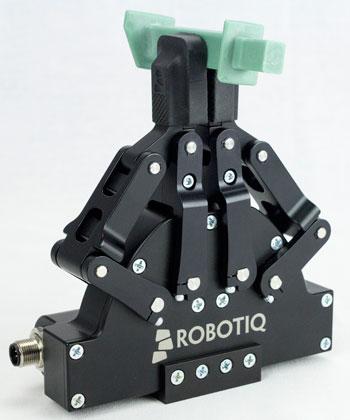- FMA
- The Fabricator
- FABTECH
- Canadian Metalworking
Holding Delicate Parts
End effectors must securely grip parts without causing damage
- September 11, 2013
- Article
- Automation and Software
The robotic handling of delicate parts can be a tricky endeavor.
Thin-walled metal parts, plastic parts, and wax patterns for investment castings all can pose problems during robotic manipulation. Even parts with extremely tight surface quality tolerances can be scrapped if not properly held.
CIM–Canadian Industrial Machinery asked expert Samuel Bouchard, president of Robotiq, St-Nicolas, Que., to discuss some of the key factors in gripping these parts with end-of-arm robotic tooling.
CIM: What are the challenges in gripping delicate parts?
Bouchard: When handling hard parts, the process usually is to set the grip firmly with high force from the end effector. However, with delicate parts, you need to have a firm grip to keep parts in the end effector, but you also need to avoid three main problems: breaking the part by gripping it too firmly, having a loose part because it is not grasped firmly enough, and marking the part by imprinting the fingers of your robot gripper on it.
CIM: What types of parts would you classify as “delicate”?
Bouchard: Delicate can mean a surface that must not be damaged, or an object can be easily crushed, or both. Examples are wax patterns for investment castings, ceramic substrate, high-end machined parts, and delicate plastic parts.
CIM: Do these parts also pose challenges during manipulation?
Bouchard: Yes. Picking the part is only one part of the problem. You also need to hold it securely while the robot is accelerating, then you need to process the part. Also, if the part is fragile, it must not be dropped when being placed or wrongly aligned if being inserted.
CIM: What is the common method of holding these parts?
Bouchard: Systems such as pneumatic grippers with custom-made jaws are still the norm, but they have difficulty creating constant low-grip force grasp after grasp. Suction cups could be OK if you have a nonporous, flat surface.
CIM: How has this changed recently?
Bouchard: On our side, we use servo grippers with articulated fingers that can conform to the shape of the parts. The servo technology makes it possible to adjust the force applied for different parts. Also, the mechanically intelligent fingers increase the number of contact points on the parts, reducing the pressure at the contact points. And, if an encompassing grip can be used, the grip does not rely on friction, and a lower grip force can be applied.
Grip detection is a built-in function. Encoder information also can be used to make sure the right part has been picked, and that it has not been crushed.
Electric servo robot grippers control the force applied on the object and the speed of the fingers. You can reach, grasp after grasp, with the perfect force applied on your parts to hold them firmly without breaking them.
You also can use an encoder value as a qualitative way to measure the same object, or to verify whether the robot gripper has picked a part in the desired way.
CIM: How is this data collected and used?
Bouchard: The data is collected in the main robot program through a communication bus and used in the logic of the program.
CIM: Delicate parts are often small. How are small parts best held?
Bouchard: It is difficult to use encompassing grips for small parts, so the best way is to have good grip force control. Using a compliant contact surface also can help, but sometimes this goes against the needed repeatability.
CIM: Are there steps the part’s designer can take to enable better holding?
Bouchard: Yes. Designers can try to create features that make them easily picked. But, in the end, the manufacturing processes must adapt to the parts, not the opposite.
CIM: What determines how a part is held?
Bouchard: We need to look at many aspects with the end user. First is the part’s features. Where can it be held securely without damaging it? Second, we need to know how the part is being presented to the robot. Is it a conveyor, bin, or pallet? Then, we examine what needs to be done with the part. For example, is it being machined, placed, or inserted? Finally, is a vision system or other type of sensing used to locate or place the part?
CIM: How will technology change to enable better holding of delicate parts?
Bouchard: Servo grippers are still not widely used. This is the next step. In the longer term, tactile sensing will play a role.
subscribe now


Keep up to date with the latest news, events, and technology for all things metal from our pair of monthly magazines written specifically for Canadian manufacturers!
Start Your Free Subscription- Trending Articles
- Industry Events
MME Winnipeg
- April 30, 2024
- Winnipeg, ON Canada
CTMA Economic Uncertainty: Helping You Navigate Windsor Seminar
- April 30, 2024
- Windsor, ON Canada
CTMA Economic Uncertainty: Helping You Navigate Kitchener Seminar
- May 2, 2024
- Kitchener, ON Canada
Automate 2024
- May 6 - 9, 2024
- Chicago, IL
ANCA Open House
- May 7 - 8, 2024
- Wixom, MI















